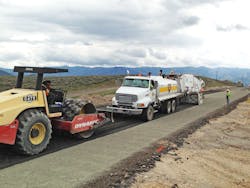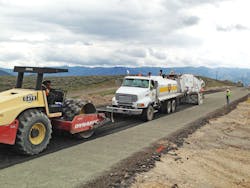Elevated thinking
Constructing, maintaining and reconstructing interstate highways can be accomplished in a sustainable, cost-effective manner.
Sustainability is an increasingly important element in the design and construction of transportation infrastructure because of limited dollars and natural resources.
Construction materials and methods can contribute greatly to the overall sustainability of a pavement. The I-80 reconstruction project from Silver Creek Junction to Wanship, Utah, embodies the true spirit of sustainability and environmental stewardship. I-80 is the major east/west corridor for truck commerce across the state of Utah. With over 45% average daily truck traffic, the existing asphalt pavement was failing to withstand the loads and environmental conditions of this mountain area. Repeated surface failures caused the Utah Department of Transportation (UDOT) to repair this section of highway early and often. UDOT decided to design a 40-year concrete pavement that would withstand the drastic mountain weather changes associated with this section of highway located at about 6,400 ft in elevation. The project ran 7.55 miles with two lanes in each direction and included the associated inside and outside shoulders. A total of 377,500 sq yd of portland cement concrete pavement (PCCP) was placed over the top of partial-depth reclaimed asphalt (PDR).
The shortest amount of time
This project was awarded to Geneva Rock Products Inc. by UDOT based on combined lowest price and shortest construction schedule. This pushed Geneva Rock to perform the work under an accelerated schedule. The project schedule required the eastbound lanes to be constructed in the fall of 2014 with the westbound lanes being constructed in the spring of the following year. A late bid date (May 2014) provided a very short window to complete the eastbound work before winter traditionally set in. All lanes in both directions had to be opened in the normal configuration during the winter months. Construction of the westbound lanes resumed in April 2015 and was completed in September 2015.
In addition to the PDR and PCCP, there was a substantial bridge along the westbound lanes that had to be demolished and reconstructed during the 2015 construction season as well as over 57,000 linear ft of permanent concrete barrier.
Mainline concrete pavement design consisted of 12 in. of PCCP placed over 4 in. of PDR. The concrete paving was performed using a GOMACO 2800 with IDBI and a GOMACO Commander III. A RTP-500 also was used to place the concrete in tight areas. Curing and texturing was done using a GOMACO T/C-600. An Erie Strayer central mix batch plant was set up at the west end of the project and produced concrete for the entire project including paving and barrier wall construction. Traffic was switched head-to-head with a temporary barrier down the middle to speed the construction and insure safety to the traveling public. This gave the contractor enough space to work safely and efficiently in order to meet the aggressive schedule. The narrow canyon provided concrete paving challenges with its limited access to the project and limited-to-no track grade. The accelerated schedule and the unpredictable mountain weather also proved somewhat challenging.
Due to the accelerated construction season in 2014, the eastbound lanes of I-80 were constructed with a traditional concrete paving mixture using a standard ASTM C150 Type II/V portland cement. The concrete mixture included 25% Class F fly ash.
The westbound lanes were constructed with a concrete mixture that was designed with sustainability in mind. This mixture utilized Holcim Envirocore cement as the hydraulic binder. The cement has a lower carbon footprint due to the incorporation of high-grade limestone, interground with the portland cement. The limestone lowers the CO2 associated with cement production. This concrete mixture also included Class F fly ash used in conjunction with the limestone cement increasing the CO2 reduction by an additional 25%. The concrete mixture significantly lowered the environmental impact from traditional concrete mixtures by utilizing blended cements and fly ash.
The two concrete mixtures performed similarly and met all concrete strength requirements for the project. Concrete batching and placement crews did not see a noticeable difference between the two concrete mixtures.
A solid platform
Another sustainable construction technology utilized on the project was that of partial-depth reclamation of a portion of the existing asphalt. Four inches of the existing asphalt was recycled by pulverizing and blending it with a percentage of portland cement to create a durable paving platform. This was the first project in the history of reclamation where only a portion of the existing asphalt was used, leaving the other portion in place. The original PDR design specified 9% to 11% portland cement in the reclamation mixture. UDOT-required strength values were between 300-500 psi in seven days. Geneva Rock, however, value-engineered test strips of PDR using 7%, 8% and 9% cement contents. It was determined that 7% cement was adequate to meet the UDOT strength requirements. This reduction in cement saved money and reduced the raw materials needed on the project.
On the I-80 project, a total of 377,500 sq yd of portland cement concrete pavement was laid over partial-depth reclaimed asphalt.
The existing asphalt was profile-milled to the desired depth. Excess tailings from the milling process were used to fill in areas lacking sufficient material. The shaping of the grade was accomplished by 3-D-guided equipment. The cement for the PDR was delivered in bulker trucks and then transferred to a spreading vehicle that spread the dry material. A rotomill then mixed the dry cement into the milled asphalt and added the specified water content. The PDR was then graded and compacted. Per UDOT specification, moist curing with water for 72 hours (or until prime coat application) was required. No construction traffic was allowed on the newly mixed PDR for 72 hours. A product called Enviroprime was used for the prime coat and served as a bond breaker between the PDR and PCCP. After proper curing, the PDR was then ready for its PCCP overlay. During the construction of the PDR it was learned that it was necessary to drive on the treated sections sooner than 72 hours. It also was found that the longer the contractor waited to place the prime coat resulted in the formation of fewer ruts. However, after two days there was little chance of reshaping the PDR.
There were many benefits to using the PDR under the PCCP. The PDR proved to be a superior paving base material, holding up well during construction activities and reducing yield loss compared to an aggregate base. However, with the cement blend it became somewhat problematic to adjust the grade easily once the material had hardened. The PDR helped the paving process remain consistent and continuous by providing a solid base, which played a major role in achieving smoothness. Additionally, because the existing materials were utilized on this project, very little waste was created and subsequently landfilled, thus reducing fuel and hauling and disposal costs, which have negative impacts on the environment. R&B

